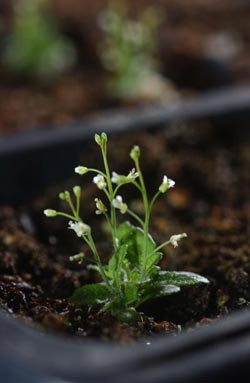Salk scientists discover how plants grow to escape shade

This is an Arabidopsis thaliana plant.<br>Credit: Courtesy of the Salk Institute for Biological Studies<br>
Mild mannered though they seem, plants are extremely competitive, especially when it comes to getting their fair share of sunlight. Whether a forest or a farm, where plants grow a battle wages for the sun's rays.
A plant's primary weapon in this fight is the ability to grow towards the light, getting just the amount it needs and shadowing its competition. Now, scientists at the Salk Institute for Biological Studies have determined precisely how leaves tell stems to grow when a plant is caught in a shady place.
In a paper published April 15 in Genes and Development, the researchers report that a protein known as phytochrome interacting factor 7 (PIF7) serves as the key messenger between a plant's cellular light sensors and the production of auxins, hormones that stimulate stem growth.
“We knew how leaves sensed light and that auxins drove growth, but we didn't understand the pathway that connected these two fundamental systems,” says Joanne Chory, professor and director of the Salk's Plant Biology Laboratory and a Howard Hughes Medical Institute investigator. “Now that we know PIF7 is the relay, we have a new tool to develop crops that optimize field space and thus produce more food or feedstock for biofuels and biorenewable chemicals.”
Plants gather intelligence about their light situation —- including whether they are surrounded by other light-thieving plants —- through photosensitive molecules in their leaves. These sensors determine whether a plant is in full sunlight or in the shade of other plants, based on the wavelength of red light striking the leaves.
If a sun-loving plant, such as thale cress (Arabidopsis thaliana), the species Chory studies, finds itself in a shady place, the sensors will tell cells in the stem to elongate, causing the plant to grow upwards towards sunlight.
When a plant remains in the shade for a prolonged period, however, it may flower early and produce fewer seeds in a last ditch effort to help its offspring spread to sunnier real estate. In agriculture, this response, known as shade avoidance syndrome, results in loss of crop yield due to closely planted rows of plants that block each other's light.
Scientists knew that a pigment found in leaves of thale cress plants, phytochrome B (PHYB), is excited by both the red wavelengths of light that drive photosynthesis, as well as the near infrared light that is enriched in shady spots. But no one had found a direct link between this response to light and the hormone-driven growth response to shade.
In their study, Chory and her colleagues, including Joseph R. Ecker, a professor in Salk's Plant Molecular and Cellular Biology Laboratory, used biochemical and genomic analyses to identify PIF7, as the key molecular link between a plant's light sensors and production of auxins.
They showed that when a thale cress plant is placed in shade, a cascade of molecular changes occurs in the cells of the leaves: the PHYB photoreceptor causes chemical changes in PIF7, which then activates genes that direct the cell to produce auxin.
“We already knew that auxin is made in the leaves and travels to the stem to stimulate growth,” says Chory. “Now we know how shade stimulates the leaves to produce auxin, and it turns out that it's a remarkably simple pathway to control such an important function.”
She added that the findings may offer new avenues for developing crops with stem architectures better suited to tightly planted field rows, making them less prone to shade avoidance syndrome. If successful, such crops would produce higher yields of foods and biofuels than existing strains.
Other authors on the paper include: Lin Li, the first author and a former postdoctoral researcher in Chory's lab; Benjamin J. Cole, Lauren J. Ivans, Ullas V. Pedmale, Hou-Sung Jung and Robert J. Schmitz of Salk Institute; Karin Ljung, of Swedish University of Agricultural Sciences; and Ghislain Breton, Chris Cowing-Zitron, Steve Kay and Jose Pruneda-Paz of University of California at San Diego.
The research was supported by the National Institutes of Health and the Howard Hughes Medical Institute.
About the Salk Institute for Biological Studies:
The Salk Institute for Biological Studies is one of the world's preeminent basic research institutions, where internationally renowned faculty probe fundamental life science questions in a unique, collaborative, and creative environment. Focused both on discovery and on mentoring future generations of researchers, Salk scientists make groundbreaking contributions to our understanding of cancer, aging, Alzheimer's, diabetes and infectious diseases by studying neuroscience, genetics, cell and plant biology, and related disciplines.
Faculty achievements have been recognized with numerous honors, including Nobel Prizes and memberships in the National Academy of Sciences. Founded in 1960 by polio vaccine pioneer Jonas Salk, M.D., the Institute is an independent nonprofit organization and architectural landmark.
Media Contact
More Information:
http://www.salk.eduAll latest news from the category: Life Sciences and Chemistry
Articles and reports from the Life Sciences and chemistry area deal with applied and basic research into modern biology, chemistry and human medicine.
Valuable information can be found on a range of life sciences fields including bacteriology, biochemistry, bionics, bioinformatics, biophysics, biotechnology, genetics, geobotany, human biology, marine biology, microbiology, molecular biology, cellular biology, zoology, bioinorganic chemistry, microchemistry and environmental chemistry.
Newest articles

Reconstructing plesiosaur swimming styles with bio-mimetic control
A research group may have unraveled the mystery behind the locomotion of the ancient marine reptile, the plesiosaur, by recreating a bio-inspired control system that accounts for motion adjustment. Extinct…

Kagome breaks the rules at record breaking temperatures
In case you’re scratching your head, we help break it down. Using muon spin rotation at the Swiss Muon Source SmS, researchers at PSI have discovered that a quantum phenomenon…

New findings on heart failure
Dysferlin protein protects and shapes the membrane of heart muscle cells. Researchers from the Heart Center of the University Medical Center Göttingen (UMG) led by Priv.-Doz. Dr Sören Brandenburg have…



